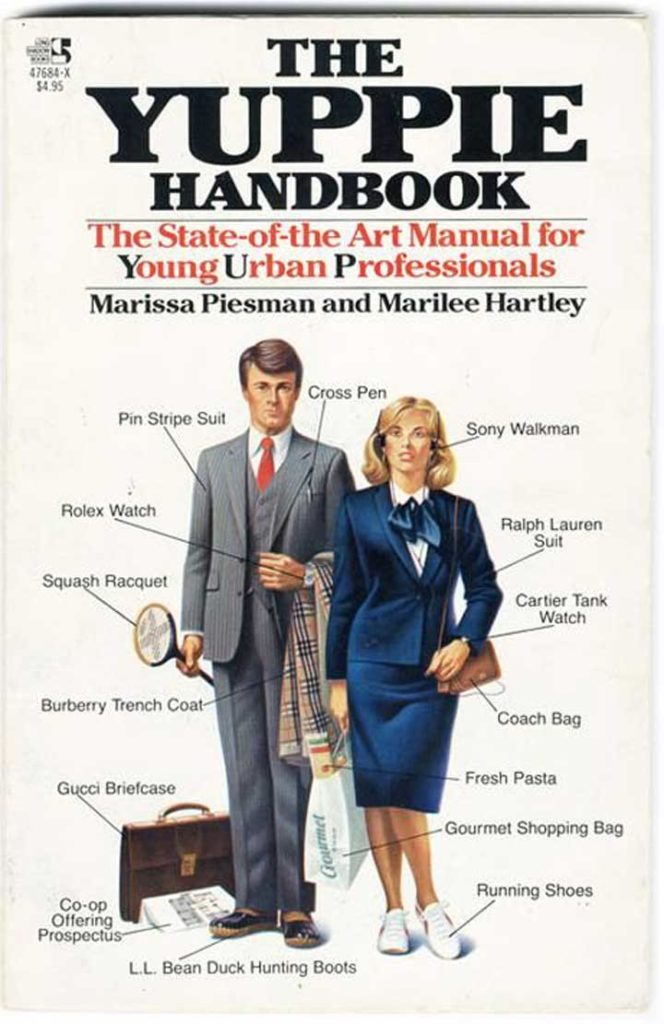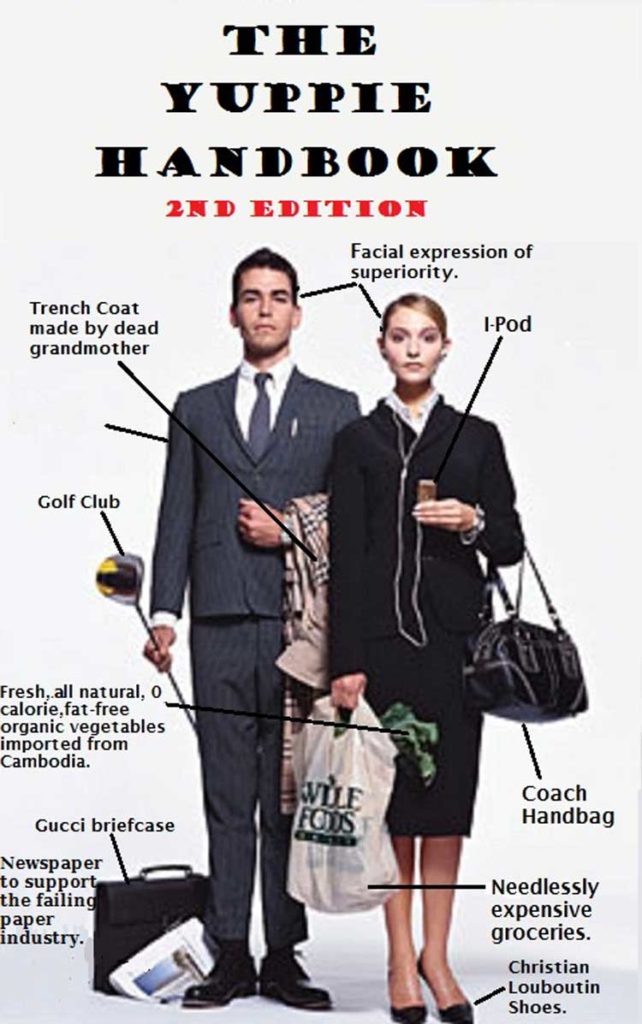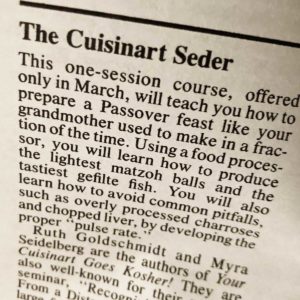

Has it really been forty years since The Yuppie Handbook? No, its copyright page says it came out January 1, 1984. But the book was so drenched in early-80s sensibility that it was already looking dated on publication date.
Coming back to it today, one gets a pungent whiff of nostalgia and wonderment. Much of it is as bafflingly antique as that fondue kit you got for Christmas in 1979 (still new-in-box, is it?).

Look at the cover here and see what I mean. The woman wears a boxy-shouldered suit with “Running Shoes.” When was the last time you heard the phrase “running shoes”?
In the early 80s, a young woman who wore a boxy “Ralph Lauren Suit” (more likely a Paul Stuart knockoff) and arrived at work in “running shoes,” was sending out obvious class signals. There was a transit strike in New York City in early April 1980, and people who lived in Manhattan walked to work, often in clunky trainers. Those heavy Adidas and Sauconys became a badge of status, announcing to the world that you weren’t a bridge-and-tunnel loser! The style spread far and wide, lingering for years as a yuppie marker, long after everyone had forgotten how the fad started.
We can’t laugh at the Sony Walkman; iPods and iPhones were for the distant future. Likewise, the “Fresh Pasta” from Balducci’s or wherever may seem naïve today as a class marker. But it reminds us there was a time, four or five decades back, when it seemed trés sophistiqué to know about “pasta,” as the cognoscenti had begun to call spaghetti, etc. If you were carrying a sack of fresh “pasta,” it suggested you’d gone to a distant neighborhood to buy it.
And now I draw your special attention to the Squash Racquet, the basic Coach Bag, and the Burberry Trench Coat. Coach and Burberry were gilt-edged brands forty years ago, but few people think of them that way now. They democratized too much, sold their goods in every shopping mall, started manufacturing in Red China. And the Burberry trademark-plaid famously tanked after it became the badge of lower-class “chavs” of southeast England, c. 2005.
The Squash Racquet needs a bit more explaining. The game of squash (or more properly, “squash racquets”) had a big vogue, 1979-1982. In New York, Boston, and Washington DC, new squash facilities sprang up like mushrooms. But then the craze suddenly crashed. It turned out most people didn’t want to play squash! If they needed to knock a little ball around a shoebox-shaped indoor court, they much preferred the prole version—racquetball—played with an ugly little short-handed paddle. Hemorrhaging cash, squash clubs accommodated them, and changed their corporate brand.
The early-80s king of the squash hill, Town Squash, Inc., renamed itself Town Sports. It lives on today as a “leisure industry” conglomerate, mainly known for its value-priced commercial gyms, e.g., New York Sports Club, Boston Sports Club, Washington Sports Club, even a Philadelphia Sports Club—in basically any city where squash once flourished.

Second Edition, c. 2006
The Fake Sequel. There was a 2nd Edition of The Yuppie Handbook (sort of), circa 2006. I don’t think it was a real book; it seems to have been a promotional item given out by a knitwear company. Here we see no squash impedimenta, or even a racquetball paddle. Instead we get a golf club. Bad choice! At this point, the annoying status symbol was a $3500 triathlon bike.
Gone too is the now-declassé Burberry. It’s replaced with a plaid-lined “Trench Coat made by dead grandmother.” I suppose the point here is that a unique, handcrafted garment made in 1939 affords more status than a pricey brand. A reasonable point, but it confutes the idea that ostentatious consumerism was the prime marker of yuppiedom.
Further along, the Coach Handbag is now an oversized “bowling bag” model of the sort that was popular around 2002, although neither it nor the Coach brand carried any cachet. Finally, instead of a Walkman, the lady carries an iPod Nano. Now, the original Sony Walkman was expensive for its day, and often hard to find. But by 2006, everyone had an iPod. No one ever thought of it as an accessory for upscale young “professionals.”
Truly, Yuppiedom faded out sometime in the 1990s, the era when corporate offices began to have Casual Friday dress codes, which soon and inevitably yielded to “Business Casual” slob culture year-round.
And now for the insides. The 1984 Yuppie Handbook was a bait-and-switch deal. The text of the book has little to do with the cover’s promise. It is coarse, tawdry, slapped-together, like something hashed out in a few days from some old cent-a-word porn-novel boiler-room.
Even more than its model, The Official Preppy Handbook (1980), it has a noticeable Jewish slant. The chapter on “Organized Religion” consists mostly of jokey comparisons of how Orthodox and Reform Jews spend “the Sabbath.” There are no Catholics, Episcopalians, Presbyterians, Lutherans within this eruv. Holy Communion for Yuppies means brioche and mimosas for brunch (yok yok yok).
The book never rises above this Borscht Belt level of wisecrack. In a chapter called “Y.U.” (Yuppie University) we get spoof course-offerings from The Learning Annex, including “The Cuisinart Seder.”

Learning Annex parody
All this would seem to subvert the book’s advertised purpose. Going by the cover and blurb, the ideal Yuppie objective is to be a stylish member of the Anglo-Celtic haute bourgeoisie, the class celebrated in the fiction of John O’Hara, John P. Marquand and Sloan Wilson. But that “Cuisinart Seder” clues us in to the authors’ frame of reference. The Learning Annex, with its ubiquitous course catalogs distributed streetside in newspaper-style racks, was a new fixture of 1980s urban living.
As with singles bars, no one regarded The Learning Annex as a yuppie preserve. But there’s a subtext here. Its courses functioned as a cover for “networking” and hookups, and thus attracted a disproportionate number of Jews. Catalog offerings were heavily weighted toward self-help gurus and pop psychology. They were thus like a downmarket version of EST, with classes that cost $35 rather than $1350.*
Seeking demographic balance, The Yuppie Handbook strives hard to be an equal-opportunity offender. We’re told about exotic subcategories, such as “Guppies” (Gay Yuppies) and “Buppies” (Black Yuppies). Guppies, the authors gush, “are really super Yuppies because they were the pioneers of Yuppie culture.” That is, (male) gays were into ostentatious consumerism and self-preening long before straight folk picked up the trend. Two incomes, no kids, right?
The “Buppies” section is a tooth-grinding read today. We’re told Buppies have “a tendency to name their daughters Keesha instead of Rebecca.” They have a “preference for custom-made suits” rather than “ethnic fashions like dashikis.” And they can talk sort of like White people, or as the authors put it, they have “carefully articulated and accentless speech,” which is why “so many Buppies get jobs as newscasters.” I’m sure we can all think of a couple better reasons.
“Prominent Buppies” supposedly include Bryant Gumbel and Arthur Ashe (though not of course the articulate, smooth-talking, luxuriantly afro’d Barack Hussein Obama, who’d just finished his two years at Columbia College).
Straining at gnats, the authors also conjure up “Juppies” (not what you think—they’re Japanese) and “Puppies,” that is, Pregnant Urban Professionals. The authors thought it might be amusing to mock thirty-something female VPs running around the office (usually to the bathroom) in business-appropriate maternity wear. But they never really explore the idea, they just point and laugh (yok yok yok).
The only people left out of the Yuppie Diversity Tent are normal, everyday Heritage Americans.
The Yuppie Handbook was one of a number of little humor books that came out in the early 1980s, all pivoting around a theme of social class. Some were better than others, but it was an identifiable genre of a place and time. We had The Official Preppy Handbook (1980), the copycat and rather clueless Sloane Ranger Handbook (1982) in England, Paul Fussell’s Class (1983), part-way inspired by Jilly Cooper’s earlier Class (1979) in England; along with whimsical parodies of L.L. Bean (Items from Our Catalog) and The New Yorker (the parody title escapes me). The most witless of these by far is The Yuppie Handbook. Its authors and producers evidently sold-in the book proposal on the strength of the name alone, but didn’t bother to figure out what made those other books work, what made them stylish and amusing.
The Yuppie Handbook was never really more than a concept (“Let’s do a Preppy Handbook…but for yuppies!”) and a cover illustration. The 8,000 words of drivel on the inside were just filler. Not a spark of wit, not a dram of insight. Usually you can judge a book by its cover, but not this time.
*Erhard Seminars Training (EST) and its later edition, the Landmark Forum, were high-pressure self-assertiveness courses created by one “Werner Erhard,” alias John Paul Rosenberg. Ayn Rand’s onetime boytoy Nathaniel Branden held similar “Power of Self-Esteem” courses through The Learning Annex. A perennial Learning Annex offering was New Age blather from one “Marianne Williamson” (real name: Vishnevetsky) whose offerings had titles on the order of, “A Short Course in Miracles.”